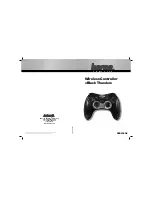
Z-5R Web
www.ironlogic.
me
Z-5R WEB Ethernet / Wi-Fi / 3G / 4G network controller
User Manual
1. OVERVIEW
Z-5R WEB Controller is used in Access Control Systems (ACS) to control a single access point.
The controller can work in standalone or network mode.
When in standalone mode, the keys are stored into database by a Master key.
In network mode, external control software is needed to operate the controller and to store keys into
database. The software also allows reading event logs, setting controller time and define valid access time
of the day for each card.
To operate in network mode, the controller is connected to network via Ethernet or Wi-Fi network adapters.
In network mode, if the connection to control software is lost, the controller still continues to work as
standalone, storing the events in the local event buffer.
Authorisation through the access points is made basing on the status of known tokens: proximity cards,
Touch Memory keys, or PIN codes. All these tokens will be hereafter called simply “keys”.
By function, the keys fall into Access keys and Programming keys categories. Access keys, in turn, can be
Normal and Blocking. Blocking keys have more rights than Normal keys.
In Normal mode, the controller grants access to both Normal and Blocking keys.
In Blocking mode, access is granted for Blocking keys, but denied for Normal Keys.
Usage example: all general employees are issued Normal keys, and security department – Blocking keys.
During working hours, the controller is in Normal mode, and all employees are granted access. Out of
hours, Blocking mode is activated and only security has access.
Master keys are the keys that program the controller. They only work for standalone controller
programming, and cannot be used for access.
Master keys allow to:
-
Add and erase Normal, Blocking and other Master keys;
-
Set time for opening signal on locking device (access control);
-
Activate and deactivate Accept Mode.
In Accept Mode, any key is granted access but also is stored into controller memory as a Normal key. This
mode helps to recover the keys database if a new ACS is being installed on a customer site where access
keys have already been issued. In this case, the controller is put into Accept Mode for some time, allowing
it to keep collecting and storing keys into its memory. Then, when the controller is reverted to Normal
mode, only already stored keys will be granted access.
To collect keys codes, the controller supports operation with two readers (one for entry and one for exit) by
Wiegand (-26, -34, -42 or -50), or iButton (Dallas Touch Memory) protocols. Each reader uses its own
separate key database in controller memory.
After access is granted to the key, the controller issues a
control signal (opening/closing a transistor) to the locking device (electromechanical or electromagnetic lock
or latch, turnstile or barrier). Locking device type and connection protocol are selected during controller
configuration.
The controller allows storing up to 8,192 events in its circular log buffer. Events include: code gained, door
sensor operated, control signal issued, etc.
To improve functionality the Controller allows to:
- Connect a door sensor to generate “Door passed” event and to reduce the “Door unlocked” alarm
duration (and reducing the locking device unlocked signal duration).
- Connect a door release (“exit”) button to open the door without need for authorisation. Connect an
external emergency unlock signal, so that the door can be opened in emergency.
Page 1

































